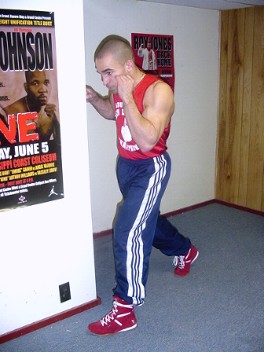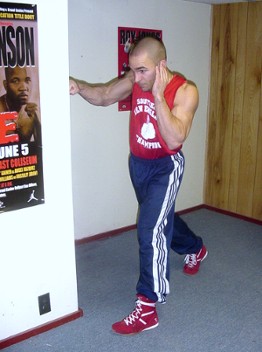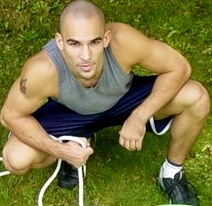
A Twist To Complex Training
By Ross Enamait - Published in 2005
Many of boxing’s training philosophies have originated out of tradition, rather than science. Trainers often refuse to change, continuing to teach archaic techniques. Unfortunately, the failure to accept change is just one of the problems. Many boxing trainers are unable to implement new techniques due to insufficient funding.
Boxing is a sport that thrives in the ghetto. Many gyms are located in city community centers that lack funding for expensive training devices. These gyms cannot afford Olympic barbell sets or other proprietary tools. Trainers are forced to work around their economic situation. Many continue to promote outdated techniques, while others implement unconventional (inexpensive) training solutions.
Consider the use of bodyweight calisthenics. I grew up boxing at a city community center. Our equipment was limited to a ring and several punching bags. There were no elaborate machines or weight sets. We succeeded with little or no equipment. Bodyweight exercise was convenient and effective.
The use of calisthenics continues today in boxing gyms across the country. Boxers are able to improve strength and endurance through bodyweight movements. Common exercises include pushups, pull-ups, burpees, sprint drills, rope skipping, and more.
Many strength and conditioning “gurus” will argue that bodyweight exercise is ineffective. Unfortunately, they are left speechless when asked to explain how so many of today’s world champions have thrived with nothing more than bodyweight exercise. Please note that I am not against the use of weight training, I am simply illustrating a point.
Professional boxing is unlike any other sport. How many other “professional” athletes work full-time jobs to support their passion? Have you ever seen an NFL player work a full day of physical labor before heading to a 2-hour practice? Although oblivious to many boxing fans, most professional fighters do not earn enough money to make a living. Consider the professional who trains 6-weeks for a $5000 payday. After training expenses and manager/trainer fees, the fighter is left with little.
The economics of boxing is partially responsible for the sport’s inability to keep pace with the mainstream sports of today. Fortunately, there are many ways to improve strength, power, speed, and endurance without elaborate training equipment.
Survival of the fittest requires that one adapt to their surroundings. If your training facility lacks equipment, you must improvise and adjust. This article will examine one low-tech solution to complex training.
First, let’s review the concept of complex training. Complex training involves the integration of resistance exercise followed by an explosive movement. Two common examples of complex circuits include:
- Weighted Squats followed by non-weighted squat jumps
- Bench Press followed by medicine ball chest pass
The resistance work activates the nervous system (ex. barbell squats), followed by an explosive movement (squat jumps) to target the fast twitch muscle fibers. The goal of complex training is the improvement of explosive strength and speed-strength.
Dr. Yuri Verkhoshansky, renowned Russian scientist, defines speed-strength as the “ability to quickly execute an unloaded movement or a movement against a relatively small external resistance. Speed-strength is assessed by the speed of movement.” (1)
An old saying in boxing is that speed kills. Anyone who has stepped inside the ring can attest to these words.
Unfortunately, many trainers fail to recognize the difference between maximal strength and speed-strength. The recent trend in combat athletics is a relentless quest for maximal strength. Coaches overemphasize the need for maximal strength when the real need is speed-strength and rate of force development. Sport biomechanist Vladimir Zatsiorsky notes that “the ability to produce maximal force and the ability to achieve great velocity in the same motion are different motor abilities.” (2)
A boxer who throws a straight right hand does not have time for significant force production. Rate of force development (RFD) is much more important. As stated by Zatsiorsky, “If the time available for force development is short, RFD is more important than maximal strength.” (2) Verkhoshansky also noted that excessive maximum strength training can impair speed-strength. (1)
Fortunately, we can use low-tech complex training drills to enhance speed and explosive abilities. The equipment requirements are minimal.
Isometric Punch Followed By Med Ball Punch
These drills will use isometrics to form the resistance portion of the complex training equation. We will train each limb independently (ex. right side, then left side). The integration of an isometric hold followed by a dynamic movement is known as the static-dynamic method of developing muscular strength. The athlete begins with a brief isometric hold, followed by a dynamic movement, explosive in nature. This style of training has been proven to be more effective at producing speed-strength than dynamic exercise alone. (1)
The boxer will begin by holding an isometric punch. A right hand boxer will assume his conventional boxing stance. He will apply pressure with the right hand against an immobile structure such as a wall. You can wear a training glove to protect the hand, or place a small pillow against the wall. Two positions will be held, the beginning of the punch motion (Figure 1) and the mid-range portion of the punch (Figure 2). Maintain each position for 3-5 seconds with approximately 80% of maximum effort.
It is important to limit the time of the isometric hold to approximately 5 seconds or less. Extended isometric holds have been shown to “decrease coordination and speed of movement and worsen elasticity of the muscles.” (1) These potential drawbacks can be avoided by limiting the length of the contraction.

|
Figure 1
 |
Figure 2
After completing the isometric holds, you will continue with a simulated medicine ball punch (additional options are shown within the video below). I recommend using a light medicine ball for this portion of the drill. The emphasis must be speed. In the video clip demonstration below, I am using a 5-pound ball. The medicine ball must be small enough to fit in one hand. The goal of this movement is to mimic the exact motion of punching. If the ball is too large, this will not be possible. More is not better when training speed-strength.
It is imperative that you throw the ball with a max effort. After throwing the ball, you will catch it from the rebounding surface and continue for 6-8 reps. Be sure to simulate the act of punching as closely as possible.
As you can see in the video demo, I have thrown the medicine ball against a large punching bag. I have improvised and used the heavy bag as a rebounding surface. You could also use a cement wall if one is available.
I also demonstrate a dumbbell shotput. It may appear odd at first glance, but it is actually quite useful for speed strength development within the upper body.
A barbell variation is also demonstrated for those who are unable to launch medicine balls or dumbbells. This movement proves to be a useful option. It will develop power, core strength, coordination, and more.
Perhaps the greatest benefit of these drills is the avoidance of deceleration. One of the drawbacks of conventional weight training is the need to decelerate at the end of the movement. Consider the bench press. After lifting the bar from your chest, you must decelerate to avoid launching the barbell into the air (chains and bands can however be used with great success).
Deceleration is a not a functional component of punching. You do not decelerate when throwing a punch towards your opponent. Your goal is to punch through your opponent.
Another advantage of these drills is the development of your non-dominant side. Many athletes possess considerable strength and coordination differences between dominant and non-dominant sides. Each of these drills includes a unilateral component that is not realized during two-hand drills.
For example, as a right-handed athlete, it will feel natural to perform a right hand medicine ball punch (simulating a right cross). It may feel awkward when training the non-dominant side (ex. left hand). When training the non-dominant side, you will need to reverse your footing. For example, a right-handed athlete will assume the southpaw stance. Your right foot will be in front when you throw the left hand medicine ball punch. You will simulate the arm action of a left cross. As a right-handed fighter, you will rarely throw the left cross. This is no reason to skip this portion of the drill. Our goal is symmetrical development. Work both sides evenly. Your coordination will improve with regular practice.
A sample routine is listed below:
Sample Routine
Right hand (left foot is in front)
- Right hand isometric punch (start position) x 3-5 seconds
- Right hand isometric punch (mid-range position) x 3-5 seconds
- Right hand medicine ball punch x 6
Left hand (right foot is in front)
- Left hand isometric punch (start position) x 3-5 seconds
- Left hand isometric punch (mid-range position) x 3-5 seconds
- Left hand medicine ball punch x 6
Repeat for 3-5 sets.
Routine Notes
- There is no rest between the isometric hold(s) and the medicine ball throws. Rest 1-2 minutes after training both sides, and then continue with another set.
- These workouts are not designed to enhance endurance. Perform these drills when the body is fresh.
- These drills are convenient, yet highly effective. You can purchase a 5-pound medicine ball for less than $15.
- The isometric punch exercise can also be utilized to strengthen the hook and uppercut. Simply stand in between a doorway and tense the beginning and mid ranges of each punch.
- Perform these drills 2 to 3 days per week.
Works Cited
- Verkhoshansky, Y. (1986). Fundamentals of Special Strength Training in Sport . Livonia, MI: Sportivny Press. (Original work published in 1977, Moscow, Russia: Fizkultura i Spovt)
- Zatsiorsky, V.M., Science and Practice of Strength Training, Human Kinetics 1995
 About the Author - Ross Enamait is an innovative athlete and trainer, whose training style is among the most intense that you will find. Ross is committed to excellence and advancements in high performance conditioning and functional strength development. He has a sincere interest in helping today's athlete in their quest for greatness.
About the Author - Ross Enamait is an innovative athlete and trainer, whose training style is among the most intense that you will find. Ross is committed to excellence and advancements in high performance conditioning and functional strength development. He has a sincere interest in helping today's athlete in their quest for greatness.